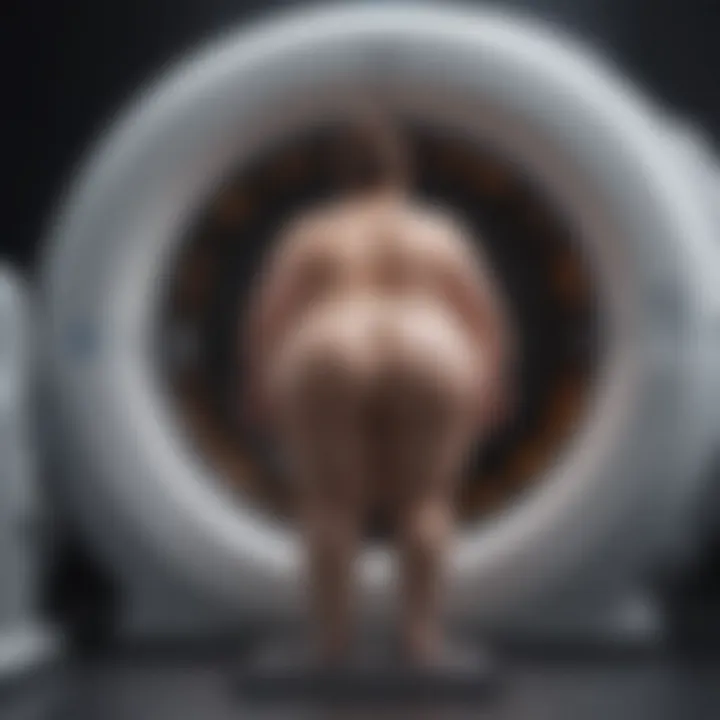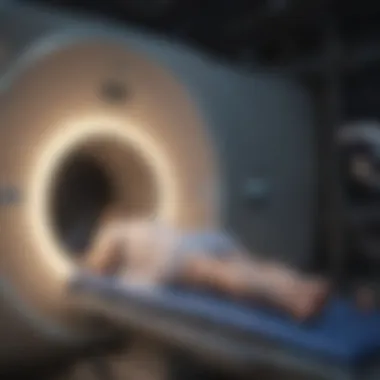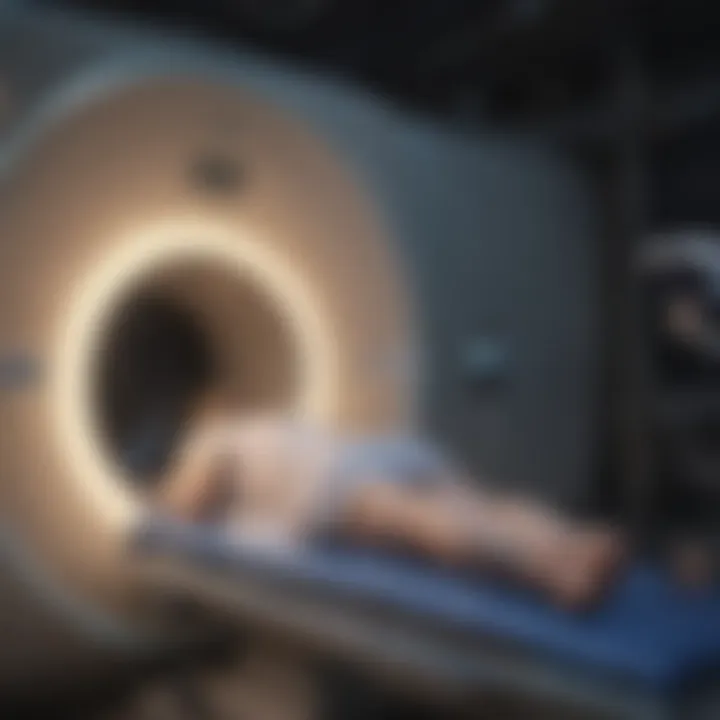MRI for Obese Individuals: Unique Challenges & Solutions


Intro
Magnetic Resonance Imaging (MRI) is a pivotal tool in modern medicine, instrumental in diagnosing and monitoring various conditions. However, when it comes to obese individuals, there are distinctive challenges that must be addressed. Understanding these complications not only assists healthcare practitioners but also improves patient outcomes.
Obesity can interfere with the MRI process in significant ways. The equipment used may not accommodate larger body sizes, and the quality of images may be compromised. Moreover, there are concerns regarding patient safety and comfort during the procedure. It is essential to explore these issues to pave the way for more effective imaging strategies for this population.
Understanding MRI Technology
Magnetic Resonance Imaging, or MRI, represents a pivotal advancement in medical imaging, especially when analyzing soft tissues and organs. Its relevance in this article cannot be overstated. Obesity introduces unique challenges, making a thorough understanding of MRI fundamentals critical. The capability of MRI to produce detailed images offers significant insight into various health conditions that can arise from obesity. Recognizing the technical nuances of MRI can help clinicians adapt their practices to better serve this demographic.
The Fundamentals of MRI
MRI relies on the principles of nuclear magnetic resonance. At its core, it involves applying a magnet to align hydrogen atoms present in the body. Once the machine generates a pulsed radio frequency, the atoms emit signals that the MRI scanner captures. This process creates intricate images of internal structures.
Essential components of MRI include large superconducting magnets, radio frequency coils, and gradient coils. Each element plays a role in generating high-quality images, allowing for detailed diagnostic examinations.
How MRI Works
Understanding how MRI works starts with recognizing the magnetic field's strength. Most clinical MRI machines operate at either 1.5 or 3 Tesla. Higher Tesla strength enables better image resolution, but it also raises technical challenges, especially in individuals with higher body mass indices.
The process begins with the patient placing their body inside the scanner's bore. The scanner uses radio waves, which penetrate the human body, to excite the aligned hydrogen atoms. The return signals are then captured and processed to create 2D or 3D images.
Importantly, the technical aspects must be tailored for obese individuals. The size limit of some MRI systems may restrict access for larger patients, affecting image quality and patient comfort.
Clinical Applications of MRI
MRI has widespread clinical applications, particularly in diagnosing conditions like tumors, brain disorders, and joint injuries. For obese patients, the utility of MRI extends into several important areas:
- Oncology: MRI is valuable in identifying tumors and assessing their size and location.
- Musculoskeletal Imaging: It aids in detecting injuries in joints and soft tissues, which is crucial for overweight individuals prone to joint issues.
- Neurological Imaging: MRI effectively visualizes brain structures, particularly in obese patients where metabolic issues may contribute to neurological conditions.
Understanding these applications is essential for healthcare providers. Addressing the challenges presented by obesity can lead to improved diagnostic accuracy and better patient outcomes.
Obesity and Its Impact on Health
Understanding the implications of obesity on health is essential for grasping not only the personal risks for individuals but also the broader medical challenges that emerge, particularly in imaging techniques like MRI. Obesity affects many aspects of health, increasing the incidence of various diseases and complicating diagnostic processes. The importance of addressing this topic lies in its impact on healthcare delivery, patient outcomes, and the necessity for tailored medical protocols. As the prevalence of obesity rises, the healthcare community must adapt to accommodate the needs of this demographic.
Defining Obesity
Obesity is generally defined as an excessive accumulation of body fat that presents risks to health. The most common way to quantify obesity is through the Body Mass Index (BMI), which calculates a person's weight in relation to their height. A BMI of 30 or higher typically indicates obesity. However, BMI does not account for muscle mass or distribution of fat, leading to debates about its effectiveness as a sole measure. Additional methods include waist circumference and body fat percentage, offering a more nuanced understanding of obesity's health implications.
Prevalence of Obesity
The prevalence of obesity has reached alarming levels in many countries. According to the World Health Organization, worldwide obesity has nearly tripled since 1975. In 2021, more than 1.9 billion adults were classified as overweight, with over 650 million of them being obese. This trend is not limited to adults; childhood obesity is also on the rise, contributing to long-term health complications. Factors influencing these statistics include sedentary lifestyles, poor dietary habits, and genetic predispositions. The implications for healthcare systems are considerable, as increased obesity rates lead to a higher demand for medical services, particularly diagnostic imaging.


Health Complications Associated with Obesity
Obesity is linked to numerous health complications, some of which significantly affect the individuals' quality of life. Common conditions associated with obesity include:
- Type 2 Diabetes: Increased insulin resistance and blood glucose levels are frequent among obese individuals.
- Cardiovascular Diseases: Higher rates of heart disease and hypertension are observed, often leading to increased mortality.
- Joint Problems: Excessive weight can strain joints, leading to osteoarthritis and chronic pain.
- Certain Cancers: Some studies indicate a connection between obesity and increased risk of several malignancies, including breast and colon cancer.
- Sleep Apnea: Obesity can lead to obstructive sleep apnea, characterized by interrupted breathing during sleep, contributing further to health complications.
These health issues present significant challenges during MRI procedures, as they can affect both patient positioning and the quality of imaging results. Moreover, their increased prevalence in the population makes it imperative for medical practitioners to adapt their techniques and equipment to ensure accurate diagnoses in obese patients.
Challenges Facing MRI in Obese Patients
The utilization of Magnetic Resonance Imaging (MRI) in obese patients is a topic of significant concern in medical practice. The challenges that arise in this field are multifaceted and have profound implications for both the quality of imaging and the overall patient experience. Recognizing these obstacles is not just vital for improving imaging results, but also for ensuring that healthcare providers can meet the needs of this demographic effectively.
Key elements include:
- Equipment limitations that affect the MRI process.
- Image quality concerns leading to diagnostic challenges.
- Patient comfort and access issues that can deter individuals from undergoing necessary scans.
These points underscore the necessity for ongoing innovation and adaptation in MRI technology and practices.
Physical Limitations of MRI Machines
MRI machines have specific design constraints that can make them unsuitable for larger patients. Traditional MRI systems typically accommodate individuals up to a certain weight limit, often around 300 to 350 pounds. When patients exceed these limits, their access to MRI may become severely restricted.
This situation creates a gap in diagnostic accuracy. Inadequate equipment can compromise the machine's magnetic field and resolution. This, in turn, affects the clarity of the images produced. Furthermore, the physical dimensions of the MRI scanner, particularly the bore size, are often too small for obese individuals, thus forcing them into uncomfortable positions that may not yield accurate results.
Image Quality Concerns
Obese individuals often present unique imaging challenges that can affect the overall quality of the MRI results. Fat tissue has different magnetic properties compared to other tissues, which can lead to artifacts in the images. These artifacts can obscure critical details and complicate the process of diagnosing conditions accurately.
For example, studies have shown that abdominal imaging in obese patients is particularly susceptible to these issues.
In some cases, the presence of excess fat can create a reduced signal-to-noise ratio, further impacting the diagnostic utility of the MRI. Consequently, radiologists may find it necessary to employ advanced techniques or adjustments to compensate for these variances, which can sometimes lead to additional costs and time delays in patient care.
Patient Comfort and Access
Ensuring patient comfort during an MRI is crucial, especially for obese individuals who may experience anxiety or discomfort while being scanned. The tight confines of a standard MRI machine can create a feeling of claustrophobia. People with larger body sizes may also experience physical discomfort, which could lead to movement during the procedure, adversely affecting image quality.
Moreover, the majority of MRI facilities may not be equipped with wider bores or larger gantry designs, leading to accessibility issues. While some centers are beginning to address these concerns by investing in open MRI technology, such options are not universally available. As a result, many obese patients may choose to forgo necessary imaging, potentially delaying critical diagnoses and treatments.
"Improving access and comfort for obese patients is not merely about accommodating a larger body size; it is about redefining our approach to patient-centered care."
In summary, addressing the challenges faced by obese individuals in undergoing MRI is essential. It requires a comprehensive understanding of the physical limitations of current machines, the intricacies of image quality affected by obesity, and the critical need for enhancing patient comfort and access. Through awareness and targeted improvements, the healthcare community can significantly improve the MRI experience and outcomes for this population.
Technical Considerations in MRI for Obese Patients
The application of Magnetic Resonance Imaging (MRI) for obese individuals cannot be overlooked. Given the increase in obesity rates, it is vital to address the technical challenges that arise in imaging these patients. These issues not only complicate the MRI process but also affect the quality of the results obtained. Ultimately, understanding and addressing these technical considerations can lead to improved diagnostic capabilities and patient care outcomes.
Parameters Adjustments for Body Size


Adjusting parameters for body size is crucial in conducting MRI for obese patients. This population often requires modifications to the standard imaging protocols. For instance, the field of view may need to be broadened to ensure that the larger anatomy is included in the scan. Furthermore, the radiofrequency pulse sequences may need to be altered to adapt to various tissue types associated with increased body fat. These adjustments may include optimizing bandwidth, repetition time, and echo time to enhance image quality.
The challenges in parameter settings extend beyond just capturing images. The lack of precision in standard settings can lead to artifacts, which may obscure important diagnostic features. Therefore, radiologists must use knowledge and experience to tailor the imaging technique for each obese patient.
Gadolinum-based Contrast Agents
Gadolinum-based contrast agents play a significant role in enhancing the clarity of MRI scans. However, their use in obese patients comes with specific considerations. For larger patients, the required volume of gadolinium may be higher to achieve the desired enhancement. It is essential for healthcare providers to monitor renal function closely, as obesity is associated with higher risks of renal complications post-contrast administration.
Moreover, the distribution of the contrast agent can be uneven in patients with high body mass index (BMI), which may lead to inconsistent imaging results. Therefore, practitioners must evaluate risk versus benefit carefully, contemplating the effectiveness of the contrast in relation to the patient's clinical scenario.
Software Advances for Obesity Imaging
Recent advances in MRI software have emerged to address the challenges posed by body size in imaging. Manufacturers are striving to develop more sophisticated algorithms that can enhance image quality while accommodating variations in body composition. Innovations such as fat saturation techniques improve visualization and minimize the interference of adipose tissue in diagnostics.
Furthermore, advanced software algorithms often enhance signal-to-noise ratios, which can compensate for the weight-related limitations of older equipment models. These advancements are pivotal in ensuring that all patients, regardless of size, receive high-quality imaging.
"Innovative software solutions can significantly elevate the imaging experience for obese patients, driving forward diagnostic accuracy."
Ultimately, a focus on technical considerations in MRI for obese individuals is vital for both diagnostic success and patient comfort. The ongoing evolution of equipment and techniques holds the potential to improve healthcare accessibility and outcomes, a critical consideration in a world grappling with rising obesity rates.
Alternative Imaging Modalities
In the context of healthcare, particularly for individuals with obesity, the concept of alternative imaging modalities becomes increasingly relevant. Standard Magnetic Resonance Imaging (MRI) can pose challenges, such as limitations in equipment and patient comfort. By exploring alternatives, providers can offer varied approaches that may improve diagnosis and patient experience. This section discusses CT scans, ultrasound applications, and emerging technologies in imaging.
CT Scans vs. MRI for Obese Patients
Computed Tomography (CT) scans provide a different approach to imaging compared to MRI. Both modalities have their respective advantages and limitations. CT scans generally have a broader availability and can accommodate patients with larger body sizes more effectively. They have faster imaging times. This can benefit individuals who might experience anxiety or discomfort in traditional MRI machines. However, CT scans utilize ionizing radiation, which is a significant drawback, especially with repeated exposure.
In contrast, MRI is non-invasive and does not involve radiation, making it a safer option overall. Yet, many MRI machines have weight and size restrictions, potentially leading to inadequate imaging capabilities for obese patients. While MRI may offer clearer soft tissue contrast, the combination of speed and flexibility with CT scans can be beneficial in certain scenarios. Each patient case should evaluate the necessity and risks related to each method.
Ultrasound Imaging Applications
Ultrasound presents another alternative visualization technique. It employs sound waves to create images, thus avoiding radiation exposure, making it a suitable option for obese individuals. Ultrasound is particularly useful for examining organs close to the skin surface. Additionally, it is more portable than MRI and CT, allowing for use in various environments, such as bedside examinations.
However, ultrasound does have limitations. The quality of images obtained can depend heavily on the operator’s skill, and results may be less reliable in obese patients due to deeper tissue layers potentially obstructing sound wave penetration. Despite these challenges, it can still serve as a valuable adjunct to other imaging modalities, offering prompt and non-invasive insights.
Emerging Imaging Technologies
As technology evolves, several emerging imaging modalities present promising options for treating obese patients. Techniques such as photoacoustic imaging and advanced MRI sequences tailored for larger body sizes are areas of increasing focus. These innovations aim to enhance resolution and depth of penetration, addressing the specific needs of obese individuals.
For instance, photoacoustic imaging combines light and ultrasound, leading to real-time monitoring without harmful radiation. Research is ongoing into developing larger and more accommodating MRI machines. The aim is to not only capture high-quality images but also ensure the emotional and physical comfort of patients, which is a vital consideration in medical imaging. Collectively, these advancements hold potential for revolutionizing the way healthcare providers approach imaging in the context of obesity.
"Understanding the various imaging modalities available is essential for improving the diagnostic process and overall patient care, especially in challenging demographics."


Improving Accessibility and Patient Care
Ensuring accessibility and quality patient care is crucial in MRI practices for obese individuals. As obesity becomes a larger public health concern, accommodating the unique needs of these patients is essential to improving outcomes and enhancing their experience. MRI facilities must evolve to provide inclusive and supportive environments for all patients. Addressing the specific requirements of obese individuals can lead to better diagnostic accuracy, reduced anxiety, and overall improved healthcare experiences.
Creating Inclusive MRI Facilities
Creating inclusive MRI facilities involves adapting existing machines and environments to cater to individuals with obesity. This includes using wider MRI machines designed with a greater weight capacity to allow for comfortable and safe scanning. Facilities should also consider the layout of the MRI room itself. Wider entry spaces and larger waiting areas can alleviate discomfort and anxiety.
Additionally, staff training on the sensitivities of working with obese patients can improve interactions. An accommodating environment reduces the stigma associated with obesity and promotes trust between patients and healthcare providers.
Training Healthcare Providers
Training healthcare providers is a significant aspect of improving accessibility and patient care. Medical staff need to understand the unique challenges faced by obese patients during MRI procedures. Training should include
- Technical skills on operating specialized equipment.
- Communication skills to effectively address any concerns and anxieties that patients might express.
- Cultural competence, ensuring sensitivity towards the complexities surrounding obesity, including potential psychological factors.
With better training, providers can create a more empathetic environment. This approach can enhance patient satisfaction and promote adherence to medical recommendations.
Patient Education and Support
Patient education plays a pivotal role in improving care for obese individuals during MRI scans. Informing patients about what to expect can alleviate anxiety and enhance their experience. Clear communication about the process, risks, and benefits of MRI helps empower patients, making them more involved in their healthcare decisions.
Support systems also need to be in place. This can include providing resources such as brochures or access to a dedicated support team, ensuring that patients have someone to speak with about their concerns.
Consider the following strategies for effective patient education:
- Pre-examination consultations to discuss procedures and what to expect.
- Visual aids or videos that explain the step-by-step process of an MRI.
- Follow-up discussions post-scan to address any questions or concerns.
"Improving patient care in MRI for obese individuals is a multifaceted approach that builds inclusivity across the entire patient experience."
By creating inclusive facilities, training healthcare providers, and offering robust educational support, MRI practices can significantly improve accessibility and care for obese individuals.
Epilogue and Future Directions
In this article, we have extensively examined the various challenges and considerations that arise when performing MRI scans on obese individuals. Understanding these challenges is not just an academic exercise; it is crucial for improving patient experiences and outcomes. As obesity becomes increasingly prevalent, medical imaging techniques must evolve to accommodate the needs of this population. In focusing on accessibility and the effectiveness of MRI practices for obese patients, we highlight the pressing need for both innovation and adaptation in healthcare technologies.
Summarizing Key Issues
It is essential to summarize the key issues identified throughout the discussion. First, the physical limitations of MRI machines, including size restraints and weight limits, pose significant barriers for obese patients. Image quality can also be compromised, impacting diagnosis accuracy. Furthermore, patient comfort should not be overlooked. The experience of anxiety and discomfort during the procedure can lead to a reluctance to seek necessary imaging. Finally, the healthcare community must acknowledge the lack of specialized training for providers dealing with obese patients in MRI settings. This gap can lead to unintentional biases and inadequate care.
- Physical limitations of MRI machines
- Compromised image quality
- Patient comfort issues
- Lack of specialized training
Call for Research and Development
To address these challenges, there is a compelling need for continued research and development in this field. Innovations in MRI technology can lead to more accommodating machines designed for larger body types, which is a crucial step towards inclusivity. Additionally, studies exploring the psychological and physiological effects of MRI on obese patients can inform better practices and enhance comfort. Training programs focusing on empathy and understanding in healthcare must be established for providers. These efforts should prioritize the overall well-being of the patient, ensuring that clinical practices are not only effective but also compassionate.
Future research should also investigate alternative imaging methods and their effectiveness compared to MRI for obese patients, as well as developments in contrast agents specifically designed for larger body dimensions. An interdisciplinary approach integrating technology, patient care, and research will enable healthcare systems to more effectively meet the needs of obese individuals.
"Enhancing the experience of obese patients in MRI settings is vital for accurate diagnosis and fostering trust in the healthcare system."
Through these concerted efforts, we can pave the way for greater equity within medical imaging, ultimately leading to improved healthcare outcomes for all.



